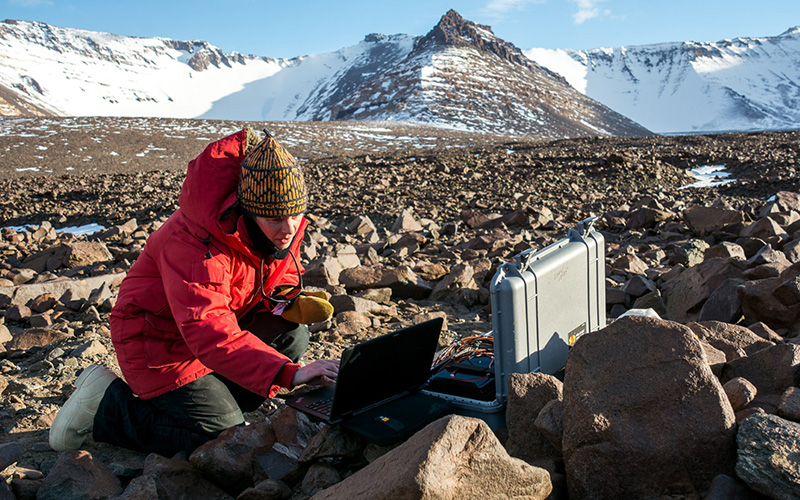Listening to Rock MusicWhat is the Sound of One Rock Cracking?Posted July 8, 2019
Rocks are cracking up all over Antarctica's McMurdo Dry Valleys. 
Photo Credit: Mike Lucibella
At the far end of the McMurdo Dry Valleys, Jen Lamp performs some final checks before leaving her experiment out for the austral winter.
Though it may take hundreds of thousands, or even millions of years, the slow but inevitable processes of weathering eventually reduce all rocks into sand or even clay. But precisely how that happens and what drives the process, is poorly understood. This year, a team of researchers set up an experiment to literally listen to these rocks at the bottom of the world. "We're trying to study erosion and weathering in the coldest, driest, windiest place on the planet," said Jennifer Lamp, an earth scientist at Columbia University's Lamont-Doherty Earth Observatory and principal investigator on the project. "We're interested in the unique processes that you find in that extreme environment." With a firmer grasp of erosion in this climate, scientists could better understand how landscapes change over time as well as to more accurately determine how long rocks have been exposed at the Earth's surface, an important benchmark for scientists trying to gauge the age of glacial deposits. Lamp's research is supported by the National Science Foundation, which manages the U.S. Antarctic Program. Why Rocks CrackThe McMurdo Dry Valleys are unlike almost anywhere else on the planet. Though originally named "dry" because they are perpetually ice-free, their extreme combination of bitter cold and barren dryness stands in stark contrast to warmer, relatively damper desert regions elsewhere in the world that have been more extensively examined. 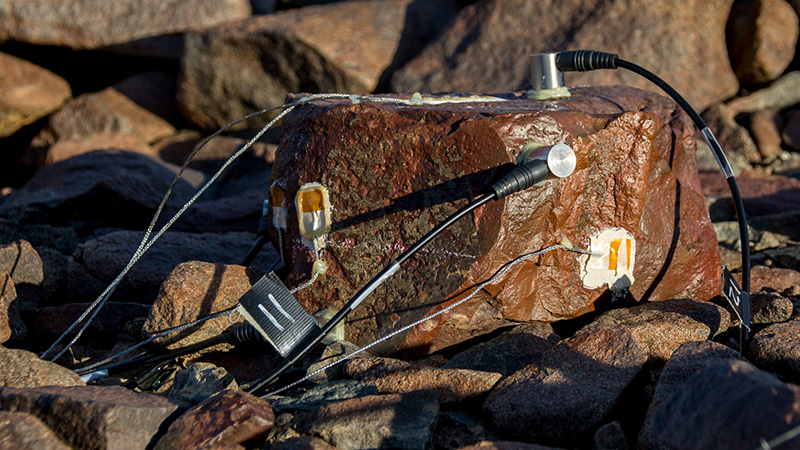
Photo Credit: Mike Lucibella
Acoustic emission monitors wired up to the team's rocks listen and record as the stones crack from erosion.
"People have been studying rock weathering in deserts for a while, but they're really focused on hot deserts," said Kate Swanger, a geologist at the University of Massachusetts, Lowell. "A lot of the conditions are similar, but a lot aren't." Getting a better understanding of what causes rocks to break down and erode away in the cold, dry deserts of Antarctica will give scientists insight into what shapes the landscape more broadly, both in Antarctica and other cold dry regions around the world. "Part of understanding Antarctic geomorphology, is understanding how rocks actually crack," said Martha-Cary (Missy) Eppes, a geologist at the University of North Carolina, Charlotte. "Understanding the factors that influence rock fracture on Earth's surface generally is something that we haven't quantified." The exceptional dryness of the Dry Valleys act as a kind of laboratory experiment to study physical weathering more closely. Water is the number-one factor that drives erosion and weathering, either by flowing over rocks and wearing them away, or catalyzing the chemical and physical processes that do. But there's so little water in the inland portions of the Dry Valleys that other factors may reign supreme. In any desert, rocks tend to be broken down by physical phenomena like blowing sand eroding away their outer layers and cracks propagating from stresses in the environment such as freezing or heating by the sun. But which of these dominate in Antarctica remains a mystery. 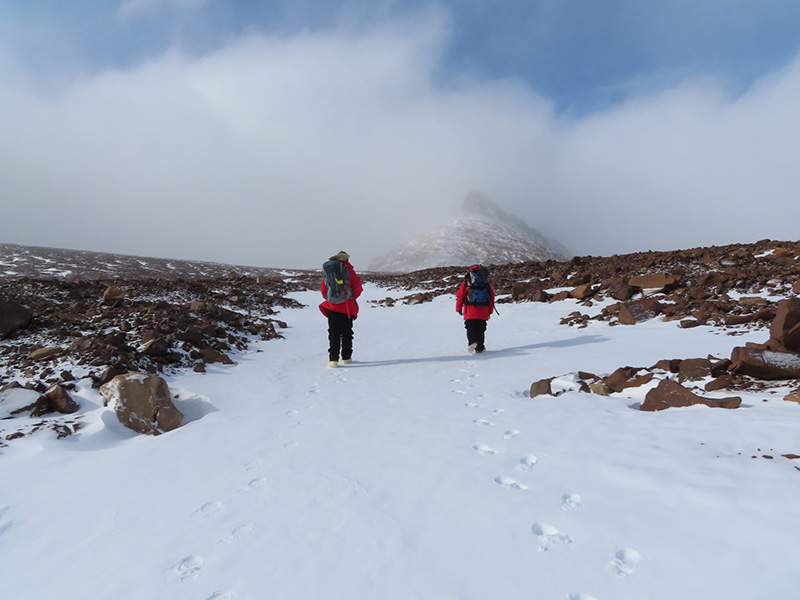
Photo Credit: Jen Lamp
Kate Swanger (left) and Missy Eppes walk along the Beacon Valley in search of rock samples to collect.
To find out how and the rate at which Antarctic rocks are breaking down, the all-woman team camped for three weeks in the Beacon Valley at the far end of the McMurdo Dry Valleys to set up their equipment. Though New Mexico may be an arid environment for North America, it's downright damp compared to the extreme climate of the McMurdo Dry Valleys. The particularly dry desert conditions of the Beacon Valley and the adjacent Mullins Valley are what attracted the team to their research sites. "There's no flowing liquid water," Lamp said. "There's no macroscopic biological life, so we don't see things like lichen or any of the other things that you see in other parts of the Dry Valleys." Their instruments are designed to "listen" to rocks breaking apart in real time to get a better idea of how often these cracking events occur and what causes them. "One of the techniques we're using is called acoustic emission monitoring," Lamp said. "Acoustic emissions are the generation of small elastic waves that come from the formation of new or propagation of existing micro-cracks." 
Photo Credit: Martha-Cary (Missy) Eppes
Jen Lamp and Kate Swanger collect rock samples along the headwall of the Mullins Glacier in inclement weather.
Whenever a rock breaks or a crack spreads, it gives off subtle elastic waves, an example of which are sound waves, which pass through the body of the rock. By attaching instruments that can "hear" these cracks, the team will know how often a rock is breaking apart and when it happens. "[The monitors] are similar to passive seismic monitoring, except that we’re looking at a smaller scale," Lamp said. Along with the monitors, the team set out a weather station next to their instrumented stones. The station records wind speed and direction, sunlight intensity, barometric pressure, air temperature and humidity. The team also wired up the boulders with temperature sensors, and a number of other nearby boulders with sensors to record their surface moisture. "The idea is to try to compare the timing of those acoustic emission events with the environmental conditions," Lamp said. "Do we see more events, which would be micro-cracks, after say snowfall or during times of fast temperature fluctuations, or in times of high wind speeds? So, the idea is to try to figure out which of those processes is causing weathering and erosion under the current present-day climate." Covering the boulders with multiple sensors lets the team isolate as much information as possible about what was happening to the rocks. "The other thing that we can do with the software that we have is to do a 3-D location on where the cracks are happening," Lamp said. "We can use the location of the cracks to say something about the process and what's happening in the rocks." 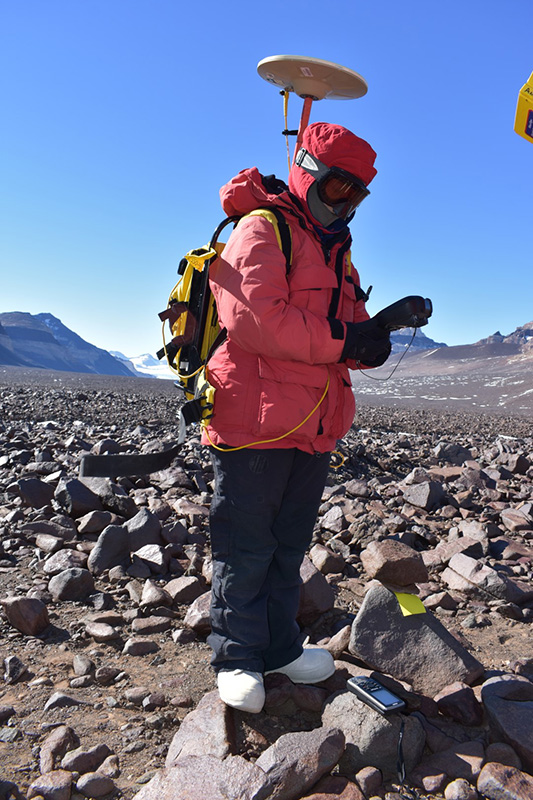
Photo Credit: Jen Lamp
Kate Swanger hauls a GPS unit to get precise location data for each rock sample they collected.
Fieldwork in a Barren LandThe team was selective about the rocks they ultimately chose to instrument, leaving no stone unturned in search of the perfect samples. "We spent about a week, almost, hiking around and identifying the absolute best boulders," Eppes said. They were looking for a range of samples with different compositions and crystal- grain structures that were representative of the different rock types throughout the valley. Once they found their four boulders, they epoxied six acoustic emission monitors to each of them and set them out under the sun. The boulders look like they have stethoscopes glued all over them with numerous cables running to the nearby computer terminal and power source. "There're wires everywhere," Eppes said. "It took quite a long time to rock all of that down and make sure the wires weren't flapping in the wind." As luck would have it, nature prepared a sort of unplanned test for the setup. Just a day or so after they finished setting out the instrumented boulders, their string of good weather came to an end. The camp was battered with a brutal storm, with wind gusts reaching 70 knots (80 miles per hour) at times. After a harrowing day huddled inside their tents, the team emerged to find that their setup had weathered the storm. 
Photo Credit: Mike Lucibella
Jen Lamp adjusts a setting on the weather station adjacent to her team's instrumented boulders.
"We're actually feeling pretty confident that it looks like the equipment was adequately anchored down and the sensors were on the rock well enough that if we leave it for the year, hopefully it will make it till next fall," Lamp said. Measuring acoustic emissions is a relatively new technique in geology. It was originally developed for engineering, listening to the telltale signs of stress cracking on bridges and other infrastructure. Eppes was among the first to use it to study the weathering of rock. She’s conducted two previous versions of this experiment, similarly instrumenting stones in in North Carolina and New Mexico. This is the first time the technique has been used in Antarctica. "We really strongly see an influence of the environment on rock cracking," Eppes said. "Rates of rock cracking increases by orders of magnitudes as [water] vapor pressures increase… but we don’t have a lot of data at extremely low vapor pressures." Space ParticlesIn addition to the instrumented boulders, the team collected more than 60 rock samples from throughout the Beacon Valley and along the Mullins Glacier, which flows into the upper part of the Valley. They're in the process of analyzing these samples, trying to determine their ages. "We're trying to quantify erosion rates over a range of time periods," Swanger said. Swanger is focusing how long it takes rocks in the Dry Valleys to break down because the actual processes of weathering and erosion can affect how scientists measure the age of rocks. One tool that scientists use to date the age of rocks is a process called cosmogonic nuclide dating. As long as a rock is exposed on the Earth’s surface, it’s bombarded by cosmic rays, particles streaming down from space that penetrate a few centimeters into the surface of the rock. These particles affect the composition of the rocks, creating isotopes embedded within them that were not originally present. By measuring the concentration of these isotopes, geologists are able to date how long a rock had been exposed at the surface of the Earth. 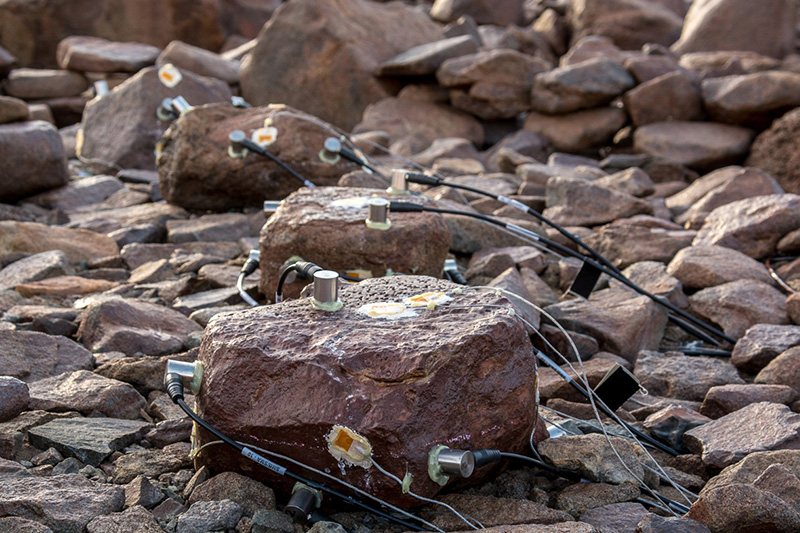
Photo Credit: Mike Lucibella
The team is hoping that the four rocks wired up with acoustic emission sensors will collect data throughout the austral winter.
At the same time, as the outer layers of the rock erode away, these isotopes erode as well. Some also undergo radioactive decay, with both processes affecting the isotopic concentration that gives scientists the ages of rocks. Researchers make assumptions about what these rates of erosion are to compensate for their loss of surface layers, but the team is hoping to use their range of samples pin down that rate more precisely. "The idea is we get a better idea of erosion rates for different rock types," Lamp said. "Hopefully next time someone goes out and is looking at landforms made of dolerite or sandstone they would have a better idea of what to assume for the erosion rate to use when they're trying to do exposure age calculations." Now that the samples have arrived at the Lamont-Doherty labs, the team is just beginning to analyze and date them. Meanwhile, thousands of miles away in the Beacon Valley, their instruments continue to listen and record the sounds of cracking rocks. At least, the team hopes so. With no way to remotely monitor their equipment, they won't know for sure if the instruments collected data throughout the austral winter until someone returns to the Beacon Valley this coming summer to download the data from their dataloggers. "They were doing a great job in February and we're cautiously optimistic that they'll survive the winter," Lamp said. The team recently received an extension to their funding to keep their instruments operating for a second year, which will significantly increase their data. Eppes, who’s conducted these kinds of experiments before, said that the longer they collect data, the more complete of a picture they get of the weathering processes. "The cracking is very nonlinear, it happens in fits and starts," Eppes said. "We're basically in a data collection period for the next year." NSF-funded research in this story: Jennifer Lamp, Columbia University's Lamont-Doherty Earth Observatory, Award No. 1744895. |



For USAP Participants |
For The Public |
For Researchers and EducatorsContact UsU.S. National Science FoundationOffice of Polar Programs Geosciences Directorate 2415 Eisenhower Avenue, Suite W7100 Alexandria, VA 22314 Sign up for the NSF Office of Polar Programs newsletter and events. Feedback Form |

